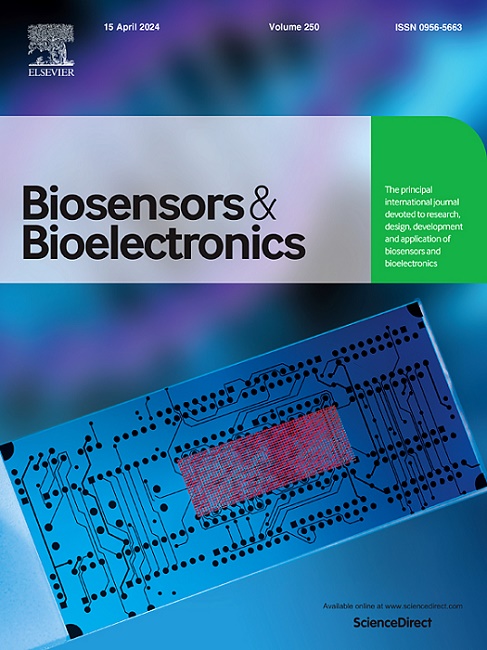Development of fluorescent-photothermal probe based on photoinduced energy transfer: A dual-readout immunosensor for the detection of illegal additive
IF 10.7
1区 生物学
Q1 BIOPHYSICS
引用次数: 0
Abstract
The development of advanced optical probes for point-of-care testing holds great importance in the field of diagnostic technologies. This study focused on the synthesis of a probe featuring both fluorescent and photothermal responses with single excitation wavelength, which was achieved through the combination of oxidized camellia oleifera shell powder (OC) and Prussian blue nanoparticles (PBNPs). Notably, OC derived from the direct processing of raw material showed fluorescent and phosphorescent emissions simultaneously, and the positions of the two peaks overlapped with the absorbance range of PBNPs, making the fluorescent and phosphorescent emissions of OC effectively quenched by PBNPs. Meanwhile, the photothermal property of PBNPs was activated by the phosphorescent emission of OC through photoinduced energy transfer. As a proof of concept, OC@PBNPs was applied in the dual-channel immunoassay, in which illegal addictive aminopyrine (AP) was chosen as the detection target. Furthermore, a portable device was developed to capture the fluorescent and photothermal signals of OC@PBNPs, rendering the detection method based on OC@PBNPs suitable for point-of-care testing (POCT).

基于光诱导能量传递的荧光光热探针的研制:一种检测非法添加剂的双读出免疫传感器。
开发用于护理点检测的先进光学探针在诊断技术领域具有重要意义。本研究的重点是通过氧化油茶果壳粉(OC)和普鲁士蓝纳米颗粒(PBNPs)的结合,合成一种具有单一激发波长的荧光和光热响应的探针。值得注意的是,原料直接加工得到的 OC 同时发出荧光和磷光,且两个峰的位置与普鲁士蓝纳米粒子的吸光范围重叠,使得 OC 的荧光和磷光发射被普鲁士蓝纳米粒子有效淬灭。同时,OC的磷光发射通过光诱导能量转移激活了PBNPs的光热特性。作为概念验证,OC@PBNPs 被应用于双通道免疫测定中,其中选择了非法上瘾的氨基比林(AP)作为检测目标。此外,还开发了一种便携式装置来捕获 OC@PBNPs 的荧光和光热信号,从而使基于 OC@PBNPs 的检测方法适用于护理点检测(POCT)。
本文章由计算机程序翻译,如有差异,请以英文原文为准。
求助全文
约1分钟内获得全文
求助全文
来源期刊

Biosensors and Bioelectronics
工程技术-电化学
CiteScore
20.80
自引率
7.10%
发文量
1006
审稿时长
29 days
期刊介绍:
Biosensors & Bioelectronics, along with its open access companion journal Biosensors & Bioelectronics: X, is the leading international publication in the field of biosensors and bioelectronics. It covers research, design, development, and application of biosensors, which are analytical devices incorporating biological materials with physicochemical transducers. These devices, including sensors, DNA chips, electronic noses, and lab-on-a-chip, produce digital signals proportional to specific analytes. Examples include immunosensors and enzyme-based biosensors, applied in various fields such as medicine, environmental monitoring, and food industry. The journal also focuses on molecular and supramolecular structures for enhancing device performance.
 求助内容:
求助内容: 应助结果提醒方式:
应助结果提醒方式:


